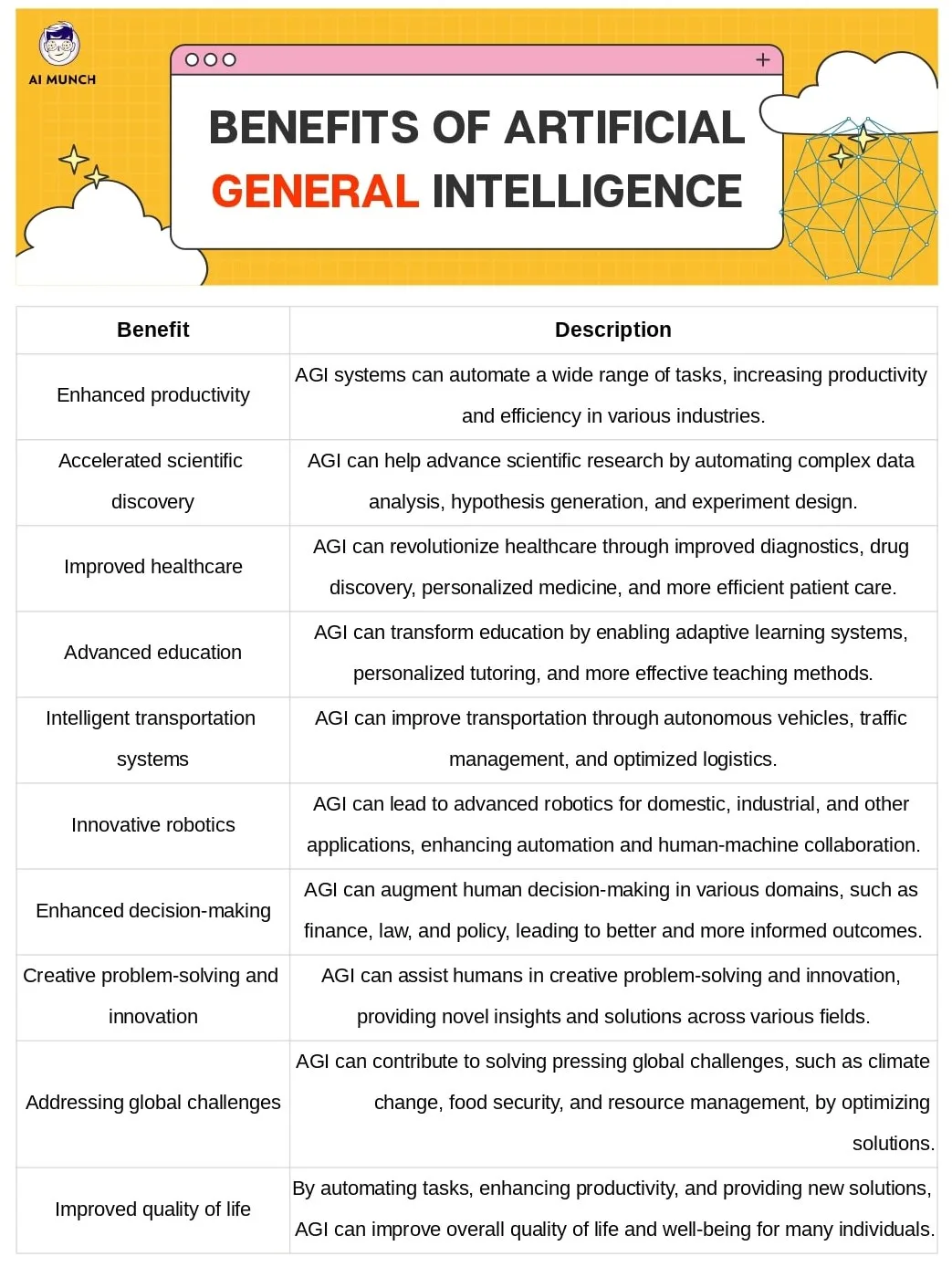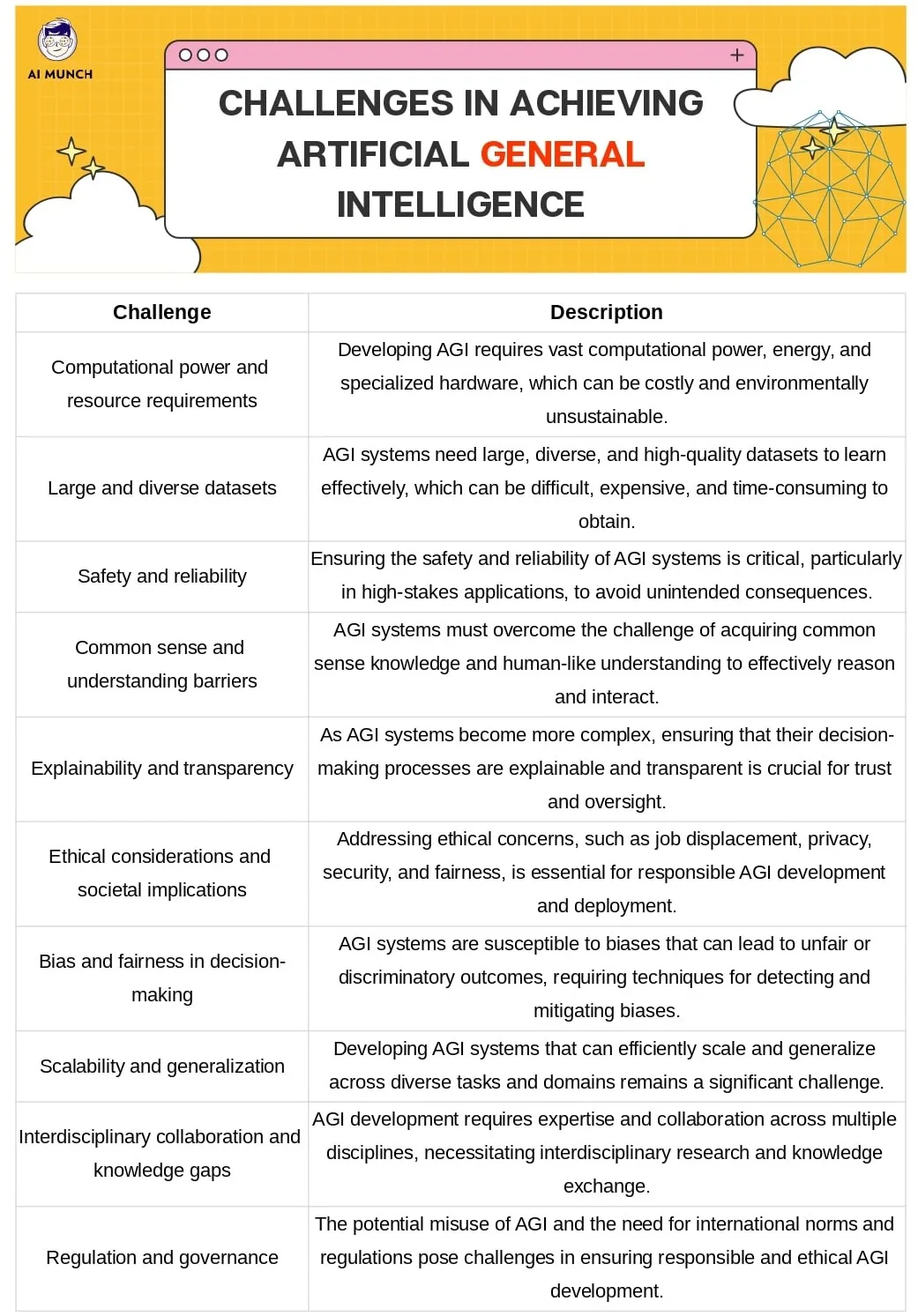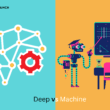Table of Contents Show
I. Introduction
Artificial General Intelligence (AGI) has recently sparked the interest of scientists, technologists, and the general public. AGI, also called “strong AI,” is a term for intelligent systems that can understand, learn, and apply knowledge to a wide range of tasks at a level that is equal to or higher than what humans can do. In this introduction, we will define AGI, distinguish it from Narrow Artificial Intelligence (AI), and discuss the potential impact of AGI on society.
A. Definition of Artificial General Intelligence (AGI)
Artificial General Intelligence is an artificial intelligence that can perform any intellectual task a human can perform. Unlike specialized AI systems, AGI is meant to be flexible and learn from experience, transfer knowledge across domains, and show reasoning and problem-solving skills like humans. Artificial General Intelligence development is an important goal for AI researchers because it could change many parts of human life and speed up scientific progress.
B. The difference between AGI and Narrow AI
We have already seen Weak (Narrow) AI vs Strong AI. Narrow AI, also known as “weak AI” in contrast to AGI, refers to AI systems designed to perform specific tasks such as image recognition, language translation, or chess play. Most of the time, these systems do well in specialized areas, but they need to apply their knowledge and skills to other tasks. Machine learning algorithms are often used. They need a lot of data and training to work well in narrow AI systems.
Narrow AI has been very successful in many applications, but it is limited because it can’t transfer knowledge between domains or understand and reason as well as humans. AGI, on the other hand, seeks to overcome these constraints by creating systems that can learn, adapt, and solve a wide range of problems without being explicitly programmed for each task.
C. The potential impact of AGI on society
The advancement of Artificial General Intelligence has the potential to cause profound social changes. The ability of AGI to learn and solve complex problems could change how healthcare, education, transportation, and finance are done. It could also speed scientific discovery by making it easier to quickly develop hypotheses, analyze data, and create new ways to solve problems like climate change, disease, and lack of resources.
But the rise of AGI brings up significant ethical and social concerns, such as job loss, privacy and security issues, and the possibility that, this technology could be used in harmful ways. As AGI research moves forward, it is crucial to consider these effects and ensure that responsible and ethical principles guide AGI development.
II. Historical Context and Evolution of AI
A. Early AI concepts and development
The history of artificial intelligence (AI) can be found in the myths and legends of early societies, which included intelligent machines and artificial beings. But it was only in the 20th century that the modern notion of AI started to take shape, thanks to the development of computing and the efforts of trailblazers like Alan Turing, who, in his 1950 paper “Computing Machinery and Intelligence,” proposed the infamous Turing test. This test was made to see if a machine is smart enough to act in a way that could be mistaken for human behavior.
In 1956, the Dartmouth Conference was the official start of AI as a field of study. The conference, which John McCarthy, Marvin Minsky, Nathaniel Rochester, and Claude Shannon organized, brought researchers together to discuss the potential for computer simulations of human intelligence. Early examples of AI research focused on symbolic reasoning were projects like the Logic Theorist and the General Problem Solver, which tried to copy how humans solve problems using logical reasoning.
B. Milestones in AI research
Numerous landmarks and innovations have been made in AI research over the years. Early AI systems like ELIZA and SHRDLU, developed in the 1960s and 1970s, showed what was possible with natural language understanding and processing. In the 1980s, there was a lot of growth in the development of expert systems, which used rule-based systems to store knowledge about a specific area.
In the 1990s, algorithms like decision trees, neural networks, and support vector machines were created. These algorithms led to the rise of machine learning as a significant area of AI research. When IBM’s Deep Blue beat Garry Kasparov in the 1997 chess world championship, AI’s ability to beat humans at complex tasks was a big step forward.
C. The emergence of deep learning and its impact on AGI
In the late 2000s and early 2010s, scientists like Geoffrey Hinton, Yann LeCun, and Yoshua Bengio made deep learning a revolutionary part of AI research. Deep learning is the process of teaching artificial neural networks with many layers of how to represent data in a hierarchical way. These Deep learning models could grow quickly and be successful because powerful GPUs and easy access to large datasets made it possible.
Deep learning has made a big difference in many areas of AI, such as speech recognition, natural language processing, and computer vision. Deep knowledge has the potential to perform complex tasks well, as evidenced by innovations like AlexNet in 2012, which significantly outperformed conventional techniques in the ImageNet Large Scale Visual Recognition Challenge. OpenAI’s GPT series and Google’s BERT are transformer models which have changed how people create and understand natural language.
Deep learning’s success has reignited interest in the development of artificial general intelligence (AGI). While true AGI is still a long way off for current AI systems, rapid advancements in deep learning and other AI technologies have brought us that much closer to realizing the long-held goal of building intelligent machines in various tasks and domains.
III. Components of Artificial General Intelligence
A. Machine learning and deep learning algorithms
Machine learning is vital to Artificial General Intelligence because it lets systems learn from data and improve their performance over time. AGI systems are built on top of machine learning algorithms like reinforcement, supervised, and unsupervised learning to adapt and generalize across different tasks. Deep learning is a type of machine learning that focuses on artificial neural networks with many layers. This makes it possible to find complex patterns and representations in large datasets.
B. Neural networks and their architectures
Neural networks are like the human brain in that they comprise connected nodes. These nodes, called neurons, process and send information. Since they allow for the representation and manipulation of complex data types like images, speech, and natural language, neural networks are essential to the development of AGI. Convolutional neural networks (CNNs), recurrent neural networks (RNNs), and transformers are some examples of neural network architectures that have been suggested to solve specific problems in Artificial General Intelligence, such as computer vision, natural language processing, and sequential data processing.
C. Natural language processing and understanding
Natural language processing (NLP) and understanding are important parts of artificial general intelligence (AGI) because they make it possible for computers to understand, produce, and reason with human language. NLP techniques help Artificial General Intelligence systems process and understand text data, which is different from natural language understanding (NLU) techniques, which try to capture the meaning and context of language to be understood like a human. NLP techniques include tokenization, parsing, semantic analysis, and sentiment analysis. Recent developments in NLP, such as transformer-based models like BERT and GPT, have improved AI systems for a wide range of language tasks. This brings AGI closer to becoming a reality.
D. Computer vision and pattern recognition
Computer vision and pattern recognition are needed for AGI systems because they make it possible to understand and make sense of visual data. Emotional AI is very helpful in this matter. With the help of computer vision techniques like image segmentation, object detection, and scene understanding, Artificial General Intelligence systems can process and analyze images and videos. Pattern recognition techniques allow objects, people, and scenes to be identified and put into groups. Convolutional neural networks (CNNs) have made a big difference in computer vision, making it easier to make AGI systems that can see like humans.
E. Reinforcement learning and decision-making
AGI systems can learn and make decisions by interacting with their environment thanks to the machine learning technique known as reinforcement learning. In reinforcement learning, agents change their plans based on the feedback they get from their actions, such as rewards or punishments. This strategy is best suited to complex, dynamic environments where making the best decisions is difficult. Reinforcement learning has been used successfully in several AGI-related tasks, such as robotics, self-driving cars, and game-playing.
IV. Promising Applications of Artificial General Intelligence
A. Healthcare: diagnostics, drug discovery, and personalized medicine
We know that Machine learning can improve business intelligence. AGI could change healthcare by automating diagnostics, speeding up drug discovery, and making personalized medicine possible. Artificial General Intelligence systems could look at a lot of medical data to find patterns and links that could help find diseases earlier and give more accurate diagnoses. By simulating molecular interactions and predicting how well a drug will work, AGI could also speed up and lower the cost of drug development. AGI could also help with personalized medicine, in which intelligent systems make treatment suggestions based on data about each patient.
B. Education: adaptive learning systems and personalized tutoring
In the field of education, AGI could make personalized tutoring programs and adaptive learning systems to fit each student’s needs and learning styles. By monitoring how students are doing all the time, AGI systems could figure out where students are struggling, suggest personalized learning materials, and give immediate feedback. This might result in more exciting and efficient learning situations and assisting.

V. Ethical Considerations and Societal Implications
Since World is already talking about Google Bard vs Bing AI, both AI giants have already warned us about artificial intelligence’s dangers.
A. The potential displacement of human jobs
AI is already affecting us in many ways. One of the biggest worries about the development of AGI is that it could take jobs away from people. We have seen a huge impact of AI in decreasing Sustainability jobs. As AGI systems get better and can do more tasks as well as better than humans, many jobs, especially those that involve routine or repetitive tasks, may become obsolete. This could cause big social and economic problems, like unemployment and a more significant gap between rich and poor. It is crucial to develop policies and strategies that ensure a just transition for workers and promote new job opportunities in the age of Artificial General Intelligence.
B. Privacy and security concerns
AGI raises important questions about privacy and security because these systems often need access to sensitive data to work well. AGI systems could collect, store, and process personal information, which could breach privacy and lead to the improper use of data. Also, as AGI gets more innovative, it could lead to new security risks, such as sophisticated cyberattacks and intelligent malware. Strong privacy and security protocols and regulatory frameworks that protect individual rights need to be made to deal with these worries.
C. Bias and fairness in AGI decision-making
Like all AI systems, AGI systems are susceptible to biases arising from the data they are trained on or the algorithms they employ. These biases can lead to unfair or discriminatory judgments when these systems are used in sensitive areas like hiring, lending, or making medical decisions. To make sure that AGI decisions are fair and equal, we need to come up with ways to find and fix biases and use training data that is diverse and includes everyone.
D. The importance of explainability and transparency
As AGI systems get more advanced and complicated, the way they make decisions must be clear and easy to understand. This is especially important in healthcare, finance, and the legal system, where AGI systems can significantly affect people. Creating ways to make these systems easier to understand and more open can help build trust, allow humans to keep an eye on them, and make it easier for humans and AGI systems to work together.
E. The potential for AGI misuse and the need for regulation
The development of AGI also makes people worry about how it could be misused, either on purpose or by accident. Artificial General Intelligence systems could be used to create powerful disinformation campaigns, fight advanced cyber wars, or build weapons systems that can fight independently. To reduce these risks, it is essential to set up international rules and regulations for the development and use of AGI and to encourage stakeholders to work together to ensure that AGI technologies are developed responsibly and ethically.
VI. Challenges and Limitations in Achieving AGI
A. Computational power and resource requirements
The requirement for a significant amount of computational power and resources is one of the major obstacles to developing Artificial General Intelligence. Modern AI models, especially deep learning architectures, often need to be trained on specialized hardware like GPUs or TPUs, which can be expensive and complex for many researchers to get. To make AGI research even less harmful to the environment, better algorithms and hardware must be made because training these models uses a lot of energy.
B. The need for large and diverse datasets
AI systems, especially those that use deep learning, usually need a lot of different and large data sets to learn well. This demand for data hinders the pursuit of AGI in several ways:
- Getting large datasets can be complex, especially in specialized fields or when data privacy is a concern.
- It is crucial to carefully select and prepare data because the quality and variety of the available data can significantly affect how well AI models work and how well they can be used in different situations.
- The focus on data raises questions about possible biases in datasets, which could unintentionally help AI make biased or unfair decisions.
C. Ensuring the safety and reliability of AGI systems
Ensuring AGI systems are trustworthy and reliable is crucial as they become more powerful and autonomous. This task entails creating reliable AI models that can deal with various situations and inputs without breaking down or having unintended effects. Making systems easy for humans to monitor, understand, and control is also important. This is crucial in high-risk applications like healthcare, transportation, and finance. To make AGI systems safe and reliable, we need to make progress in AI that can be explained and find ways to find and fix potential risks and weaknesses in AI algorithms and architectures.
D. Overcoming the “common sense” and “understanding” barriers
The requirement to provide AI systems with common sense knowledge and understanding is a significant barrier to the development of Artificial General Intelligence. Common sense is the basic information about the world that people learn through experience. It helps them think clearly and act right when things change. Even AI systems that are very good at learning need help with tasks that require common sense or awareness of the situation. This makes them unsuitable for general–purpose applications.
Researchers are looking into different ways to get around these problems, such as making new learning algorithms that teach and use common sense. These building models incorporate outside knowledge sources like ontologies or databases and design AI systems that can learn more effectively from sparse or unsupervised data. The AI research community can significantly advance toward achieving the long-sought objective of Artificial General Intelligence by addressing these difficulties and constraints.

VII. Future Prospects and Research Directions
A. Advances in AGI algorithms and architectures
AI can create millions of jobs. Future research into Artificial General Intelligence will probably focus on making algorithms and architectures that can better learn, reason, and adapt to different tasks. To make AGI systems more flexible and reliable, combining different types of AI, such as deep learning, reinforcement learning, and unsupervised learning, may be necessary. Researchers will also look into new ways to build neural networks and learn more, like how humans think, which will help them make AGI.
B. The role of quantum computing in AGI development
Quantum computing has the potential to completely change the way AGI is made because it is so powerful. It does this by using the concepts of quantum mechanics to perform computations. Quantum computers could speed up research, which could lead to new AGI algorithms and techniques by quickly processing large datasets and complicated tasks. But we still need to find out what the full effects of quantum computing will be on AGI because there are still a lot of problems to solve before quantum computing can be used in the real world and on a large scale.
C. The potential for AGI-human collaboration and augmentation
There is an increasing interest in researching how humans and AGI can work together productively and improve each other’s capabilities as these systems become more powerful. This could mean making intelligent user interfaces, tools, and techniques that help people be more creative, solve problems better, and make better decisions. By combining the strengths of humans and AGI systems, this collaboration could lead to more efficient, creative, and effective results in many areas, from scientific research to making art.
D. The importance of interdisciplinary research in AGI
AGI needs knowledge and help from many fields, such as computer science, cognitive science, neuroscience, psychology, and ethics. Interdisciplinary research can help find new ideas, methods, and points of view that can help AGI grow and deal with its problems. Researchers can better understand the complexity of intelligence and work toward making these powerful and morally responsible systems if they encourage collaboration and knowledge exchange across these fields. Neuralink is the best example of this.
VIII. Conclusion
A. The potential benefits and transformative impact of AGI
AGI research can potentially have significant positive effects and fundamentally alter society. Artificial General Intelligence has the potential to make our lives much better and help solve some of the world’s biggest problems. It could automate many tasks, speed up scientific discoveries, and change many industries. But to get these benefits, there are a lot of social, ethical, and technical problems that must be solved.
B. The need for responsible development and deployment
As AGI research grows, it is vital to make sure that it is made and used in a way that is ethical and responsible. Addressing job displacement, privacy, security, and fairness issues is essential while promoting transparency, explainability, and human-AI collaboration. AGI can be beneficial in increasing environmental jobs. There will be huge demand for environmental science jobs and renewable energy jobs, in the coming future. By bringing together people from different fields and backgrounds, we can shape the future of AGI in a way that makes the most of its benefits and minimizes its risks.
C. The uncertain but exciting future of AGI
Many problems and questions still need to be resolved, making the future of Artificial General Intelligence uncertain. But the chance to build intelligent systems that can think, learn, and adapt to different tasks is exciting and could change the game for humanity. We can help AGI reach its full potential and give our society new opportunities by pushing the limits of AI research and encouraging people from different fields to work together.
FAQs
Narrow AI, also known as weak AI, is designed to perform specific tasks or solve particular problems. AGI, on the other hand, has the potential to generalize its learning and reasoning abilities across a wide range of tasks, similar to human intelligence.
Numerous industries, such as healthcare (diagnosis, drug discovery), education (adaptive learning systems), transportation (autonomous vehicles), robotics (domestic and industrial), and finance, could benefit from the use of AGI. (fraud detection, automated trading).
AGI refers to AI systems that are very self-sufficient and can learn, understand, and do any intellectual task that a human can do. It represents a significant leap from narrow AI designed for specific tasks only.
Ethical concerns surrounding AGI include potential job displacement, privacy and security issues, bias and fairness in decision-making, explainability and transparency, and the potential for misuse and the need for regulation.
AGI is hard to make because it needs a lot of different and large data sets, it needs to be safe and reliable, it needs to get past common sense and understanding barriers, and it needs to deal with ethical and social issues.
AGI is committed to sustainable business practices, and we take great pride in our direct and long-standing contributions to global food security and our support for the United Nations’ Sustainable Development Goals. We will see more and more jobs in sustainability and environmental science.
AGI can only be made with interdisciplinary research because it needs knowledge and cooperation from many different fields, such as computer science, cognitive science, neuroscience, psychology, and ethics. Researchers can better understand the complexity of intelligence and work toward making AGI systems that are both powerful and morally responsible if they encourage collaboration and knowledge exchange across these fields.
Do you want to read more? Check out these articles.










